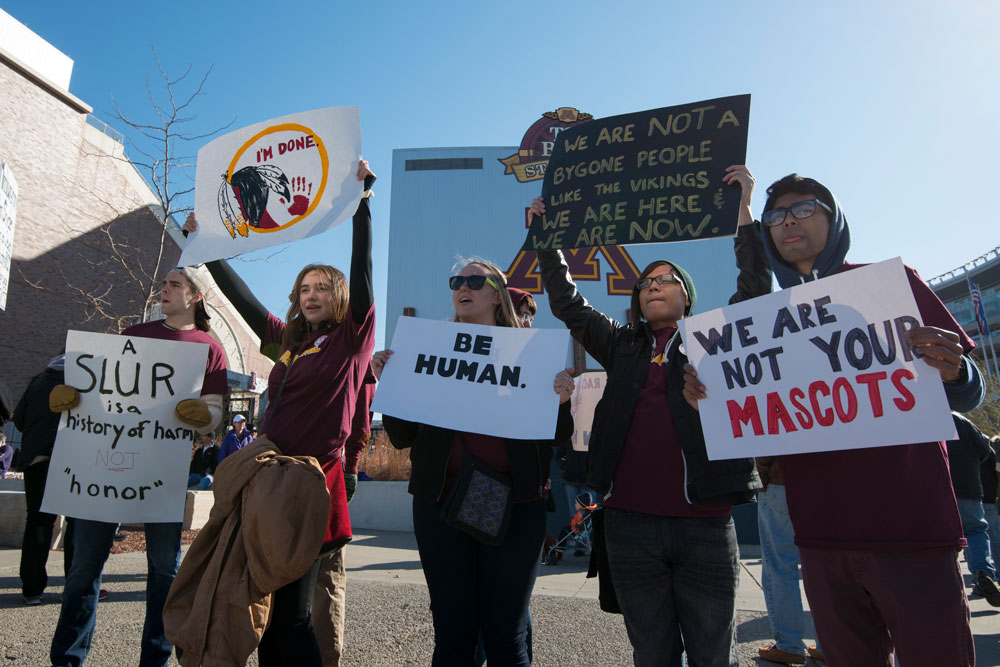
October 1, 2019; Wisconsin Public Radio
A mascot is “a person, animal, or object adopted by a group as a symbolic figure, especially to bring them good luck.” Most of the time, they’re extremely dramatic caricatures portrayed by people dressed in bright costumes. Typically, mascots use a mix of physical humor and zany shenanigans to excite crowds, inspire players, and even amusingly taunt opponents. These tactics help knit together a shared identity that is integrated into merchandising, which fans purchase and proudly display to support their team. Every school’s mascot is a symbol—it gives fans something to rally around. Yet mascots can undermine this goal when they reinforce negative stereotypes.
In Wisconsin, as Rob Mentzer of Wisconsin Public Radio notes, 18 school districts are supporting a resolution to end the use of Native American mascots statewide, which is expected to be introduced into the state legislature in January. Wisconsin is following other states. Massachusetts has a bill pending (H.443), which seeks to prohibit “the use of Native American mascots by public schools in the commonwealth.” And as NPQ reported, in May the Maine Legislature voted unanimously to ban Native mascots from public schools throughout the state.
Though this political traction is promising, there are still an estimated 1,000 schools and sports teams throughout the United States that still have mascots depicting Native Americans. Many don’t understand why this is an issue. Let’s break it down.
First, mascots depicting caricatures of Native Americans ignore the incredibly rich and diverse cultural history of Native peoples by reducing it into a distorted cartoon image. In the United States alone, there are over 573 federally recognized American Indian and Alaskan Native nations, each culturally, linguistically, and ethnically unique.
Sign up for our free newsletters
Subscribe to NPQ's newsletters to have our top stories delivered directly to your inbox.
By signing up, you agree to our privacy policy and terms of use, and to receive messages from NPQ and our partners.
By misrepresenting Native Americans through mascots, schools and sports teams homogenize this diversity, reinforcing the myth of the “vanishing Indian,” while at the same time embodying the colonial mindset of stripping cultural identities in the name of progress. In fact, hijacking cultural identities to make them into new ones beckons to mind the scores of Native American children that were brutally kidnapped from their families, shipped off to boarding schools, and beaten as an assimilation method.
But, you say, it’s just a sports mascot, right? Well, that’s the not-so-funny thing about the colonial and genocidal history of America. The most sobering example of the intersection of genocidal history with sports caricature is the use of the term “redskins,” which hauntingly is used by an NFL team based in Washington DC. While some suppose that the term is derogatory simply because it describes the skin color of people, which would be bad enough, its roots are far more grotesque, and paint an unembellished picture of early America. As the National Congress of American Indians 2013 report on the topic notes, “The term originates from a time when Native people were actively hunted and killed for bounties, and their skins were used as proof of Indian kill. Bounties were issued by European companies, colonies, and some states, most notably California.”
In other words, red skins, the scalps and tanned hides of murdered Native Americans, were exchanged for bounties. Redskin bounties were used as part of a cohesive strategy in the genocide of nearly 10 million Native Americans in the United States. Today, the term describes a Native American mascot for a professional football team in our nation’s capital. Think about that for a moment.
Most people make the mistake of conflating what a mascot means for fans with what it represents to Native Americans. When history is relegated to a disposable cup mindset where cultural diversity is distilled into images designed to make money, stir up competition, and minimize identity, it’s a problem.
Simply put, caricatures of Native Americans as mascots create goofy associations that dangerously diminish historical realities of genocide, undermine complex cultural identities, and perpetuate ignorance and stereotypes about Native Americans. The efforts in Wisconsin and in other states to once and for all decisively dismiss this practice deserve a closer look.—Derrick Rhayn













